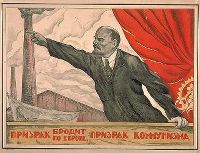The reasons for the demise of Sargent's popularity and his art's rebirth
| (Page 3 of 4) |
| The Fall and Rise of Sargent
(Frontpage) (What's
New)
The reasons for the demise of Sargent's popularity and his art's rebirth |
|



Artist unknown. "There is a spectre haunting Europe; the spectre of Communism." 1917-1924? Note: The text is from the Communist Manifesto Marx & Engels 1848. (PBS "Redfiles")
|
Any criticism of Sargent was insignificant to his enormous popularity. John was sought after as the most highly regarded portrait artist, the most prestigious museums in America and England were scrambling to acquire his work both in oils and watercolors, and universities were heaping one honorary degree after another upon him. In 1917 he was cornered by John D. Rockefeller who wanted his portrait done. John refused, giving his standard answer of no more portraits, but Rockefeller wouldn't take no for an answer. Sargent finally relented and painted two portraits for $15,000 each. As popular as he was, there was an undertow pulling at the foundation of public opinion. A tidal shift eroding the life that Sargent knew. He didn't see it coming and he clearly didn't understand it. The First World War had brought an end of an epoch. While Sargent was painting murals for Harvard in memorial, the bulk of the blood shed on Flanders Fields didn't come from the rolls of Harvard, or Yale. As in most wars, the wealthy and politically connected were, by and large, conspicuously absent from the long list of the dead. People were upset. The undercurrent was bitter. The Gilded Age had brought on a war that in retrospect seemed pointless and costly. Millions had died and for what? While Sargent was painting Rockefeller in Florida and then again in New York, the Bolshevik Revolution was Sweeping Russia and John Reed was writing "Ten Days That Shook the World". By the end of the war the Kaiser government was left imploding. Spain was on the verge of a civil war. Henry Ford was fighting against any sort of unionization in America. At Sargent's memorial Exhibition at the Royal Academy E. M. Froster looked upon the walls at Sargent's paintings with disgust: A pall of upholstery hung over the exhibition . . . . [The portraits] gazing at each other over our heads, said, “What would the country do without us? We got the decorations and the pearls, we make fashions and wars, we have the largest homes and eat the best food, and control the most important industries, and breed the most valuable children, and ours is the Kingdom and the Power and the Glory”And Roger Fry weighed in: That Sargent was taken for an artist will perhaps seem incredible to the rising generation. We must abandon, then, this futile search for aesthetic values in Sargent’s work – a search into which the misleading use of the word “artist” has led us . . . We must look at these pictures not as works of art . . . but as illustrations or reports about other things . . . For Royalty or the genuine aristocrat he seems to have felt the same glamour as the great mass of the English middle classes . . . on his holiday travels . . . Those rapid and accomplished diaries in water-colour which he used to bring home . . . what he saw was exactly what the average upper-class tourist sees . . . what surprises is the uniform superficiality of the observation . . .As time proved Roger Fry to be the prophet of the new age of modern art, critics began to parrot Frys' assessment of Sargent, and by the 1930's it was chic to dislike Sargent. He became the poster-boy for everything Edwardian and for the young he became the target for all things wrong with the Royal Academy. "He was lapdog for the rich." "He only painted for money." In a span of less than 10 years, the meteor flight of Sargent's popularity came blazing through the atmosphere and was smoldering on the ground with the ashes of the Gilded Age. As late as 1987 a study showed Sargent's work to be the "worst investment" of any major artist between 1935 and 1987. Fairbrother, in his book, offers San Vigilio as an example which sold at auction from John's estate in 1925 for $35,280, then resold in '52 for a mere $294 -- both adjusted for inflation. (Fairbrother, P.140) By the 1950's Sargent was marginalized and perceived as just a "society artist" -- insignificant. Fry had been right -- or had he?
By Natasha
Wallace
|
